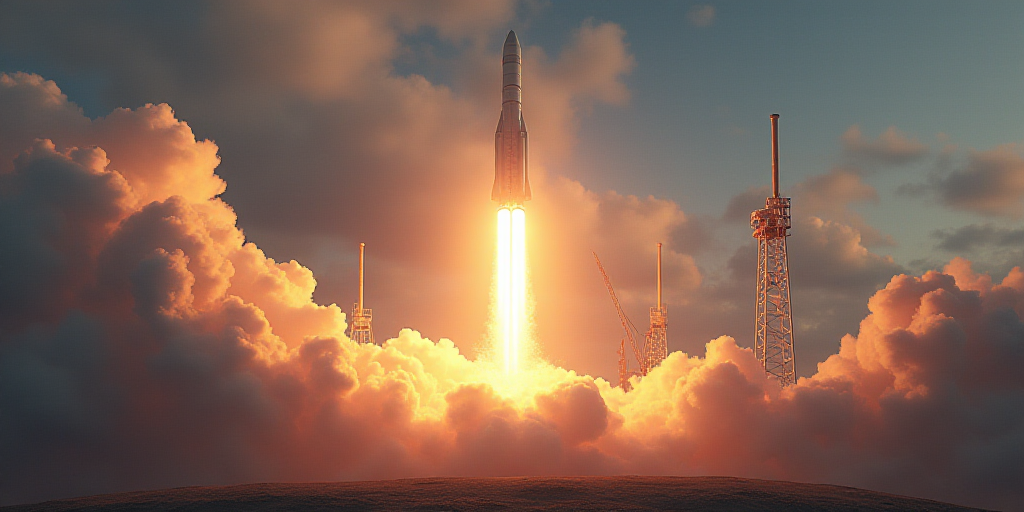Elon Musk’s SpaceX Achieves Crucial Test Flight for Martian Ambitions
SpaceX, the aerospace company founded by Elon Musk, successfully launched its massive Starship prototype on Tuesday, following two recent test failures that resulted in spectacular explosions. The Starship, standing at 123 meters tall, is the world’s largest and most powerful rocket, playing a pivotal role in Musk’s plans to reach Mars.
Background on Elon Musk and SpaceX
Elon Musk, the CEO of SpaceX and Tesla, has long been an influential figure in the aerospace industry. His ambitious goals include making human life multiplanetary, with Mars as a primary target. SpaceX has already made significant strides in reusable rocket technology, reducing the cost of space travel and paving the way for more frequent missions.
The Starship and its Importance
Starship is designed to be a fully reusable spacecraft system, consisting of a Super Heavy booster and a Starship spaceship. This two-piece design allows for more extensive missions, including trips to the Moon and Mars. The successful test flight on Tuesday brings SpaceX one step closer to achieving its Martian ambitions.
Test Flight History and Challenges
- This test flight marked SpaceX’s ninth attempt since the failures in January and March, which resulted in dramatic explosions over the Caribbean.
- In previous tests, the first stage of the rocket successfully returned to the launch site and was captured by mechanical arms, showcasing SpaceX’s advanced technology.
- However, the massive Starship exploded in the air during both failed tests, prompting authorities to reroute flight paths and postpone launches.
- Four of the eight previous test flights ended in explosions, with some being deliberate and others not. In 2023, several organizations filed a complaint against US authorities for underestimating the environmental impact of Starship tests.
FAA Approval and Increased Launch Frequency
Despite the setbacks, SpaceX remains confident in its rigorous testing strategy, which has established the company as a leader in commercial space travel. In early May, the Federal Aviation Administration (FAA) approved an increase in annual Starship launches from five to twenty-five from its Texas base following an extensive environmental review.
The FAA’s launch approval stated that the closed airspace around the launch site was nearly doubled to 1,600 nautical miles east of the launch pad. For this test flight, the FAA coordinated directly with the United Kingdom, the Turks and Caicos Islands (under British control), the Bahamas, Mexico, and Cuba.
Test Flight Details and Innovations
During this test flight, the upper stage attempted to orbit the Earth and perform a soft landing in the Indian Ocean. A new development in this mission was the deployment of Starlink satellite prototypes as a payload, which are expected to be destroyed upon atmospheric re-entry.
Another innovation showcased during this launch was the reutilization of a first stage that had previously flown and been recovered. This step further advances SpaceX’s goal of fully reusable rockets, potentially reducing costs and increasing mission frequency.
Key Questions and Answers
- Who is Elon Musk? Elon Musk is a South African-born entrepreneur and businessman, best known as the CEO of SpaceX and Tesla. He is also a co-founder of PayPal.
- What is SpaceX? SpaceX is an American aerospace manufacturer and space transportation company founded by Elon Musk in 2002. Its mission is to reduce space transportation costs and enable the colonization of Mars.
- What is the Starship? The Starship is a fully reusable spacecraft system developed by SpaceX. It consists of a Super Heavy booster and a Starship spaceship designed for missions to the Moon, Mars, and beyond.
- Why is the Starship test flight important? The successful Starship test flight brings SpaceX closer to its goal of establishing a human presence on Mars, showcasing advancements in reusable rocket technology and paving the way for more ambitious missions.






